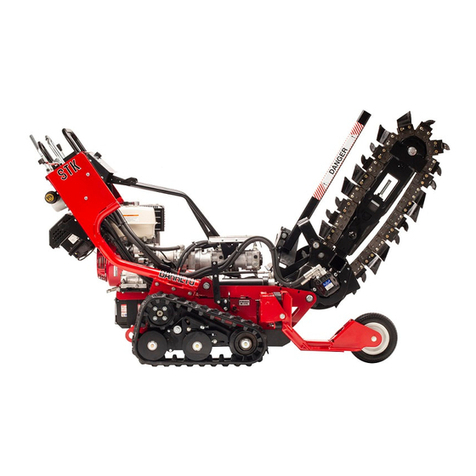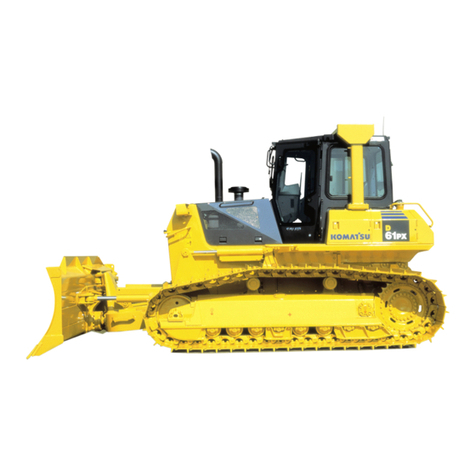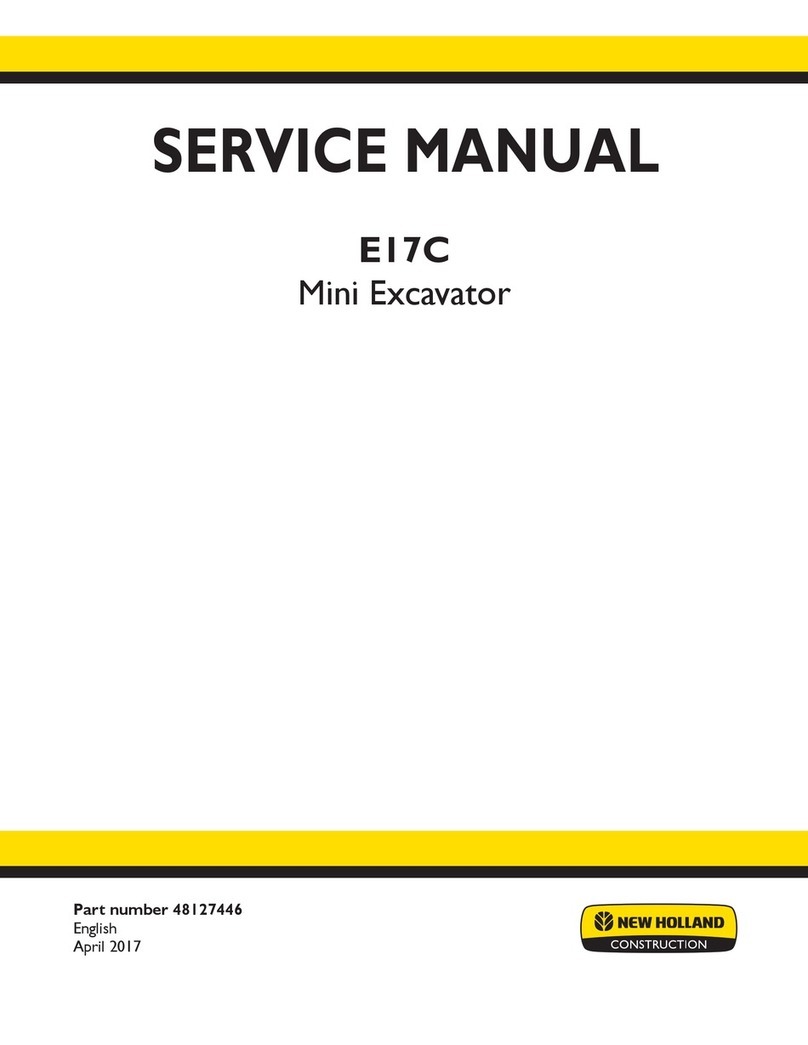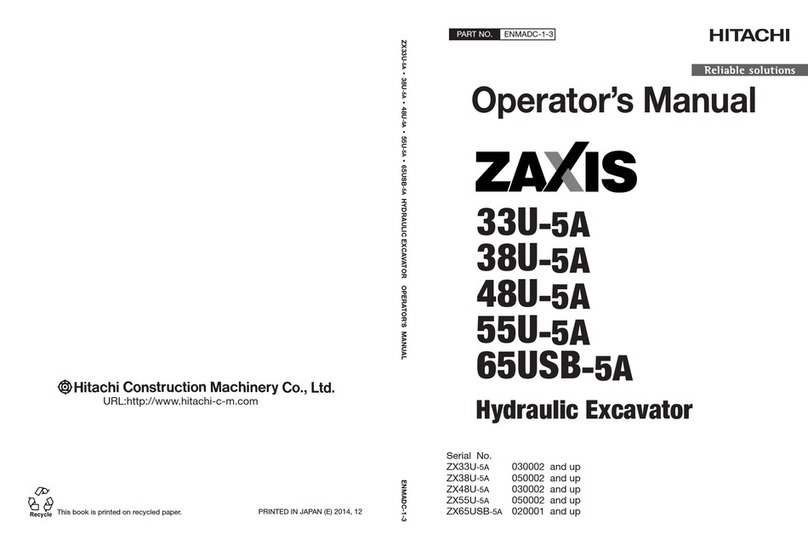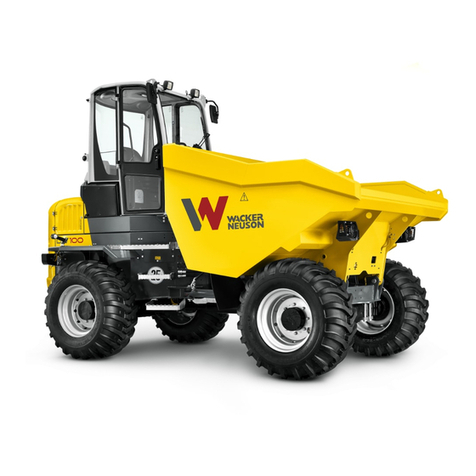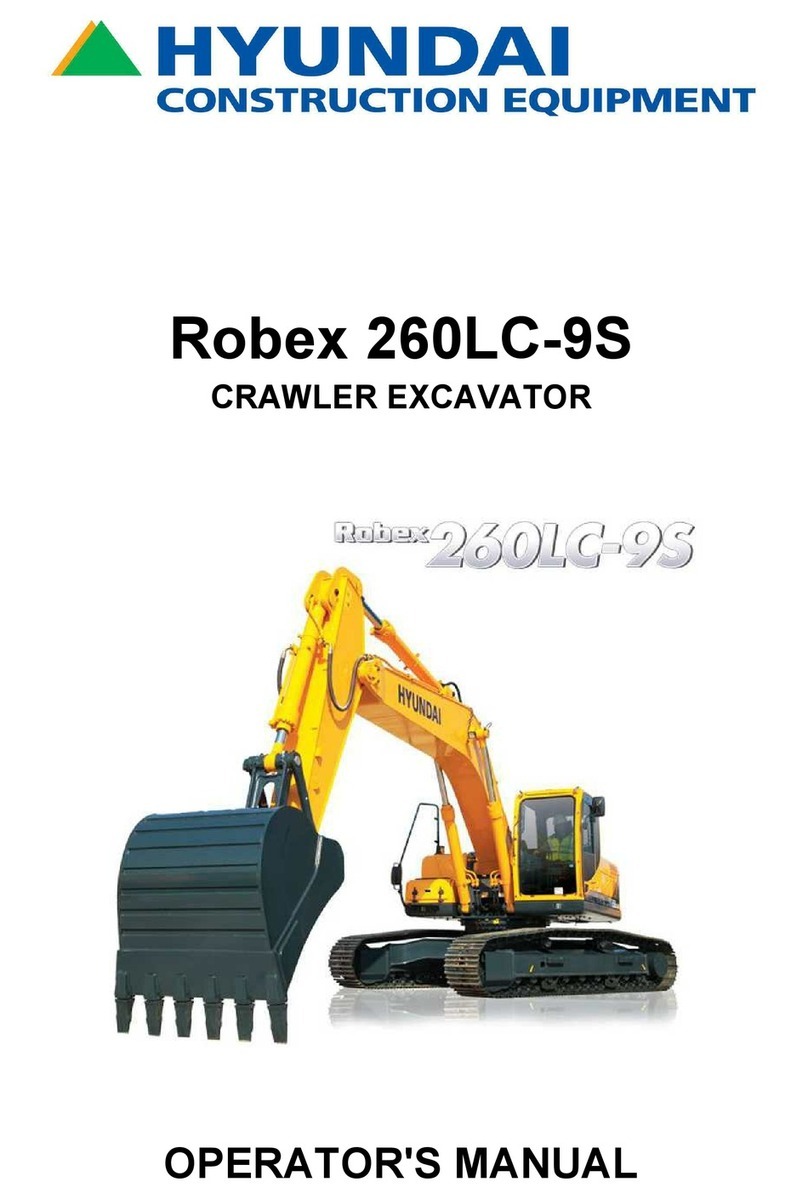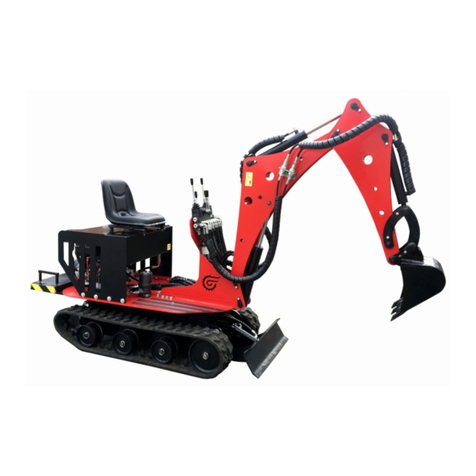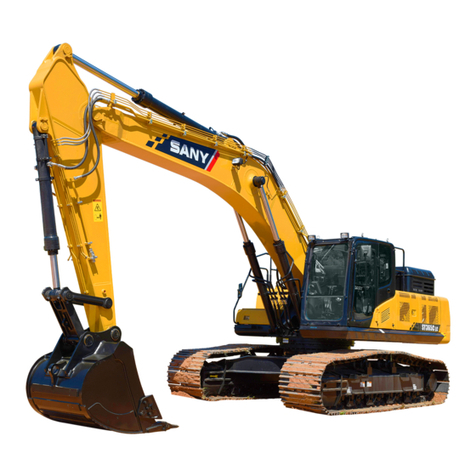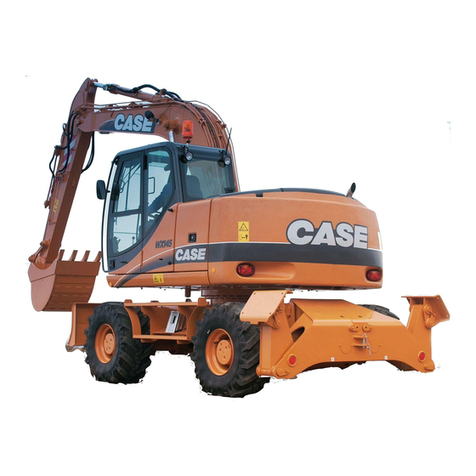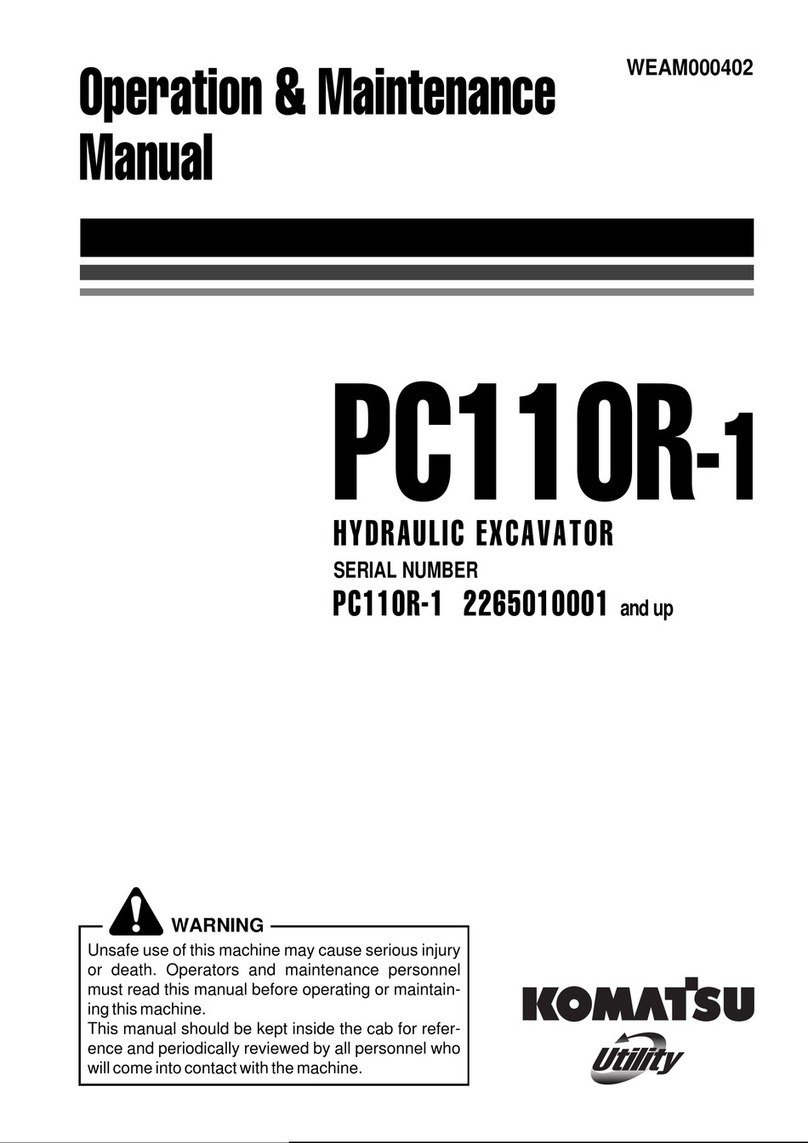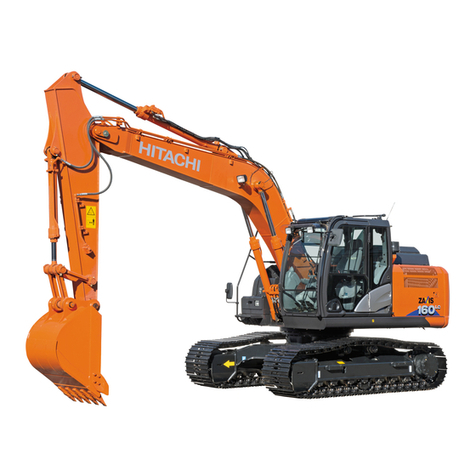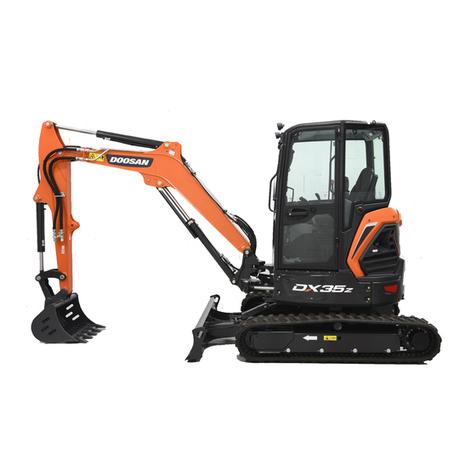Barreto 1824TK User manual

1824TK - 2324TK OPERATOR’S MANUAL 1/24/12 Page 1 of 20
THE
MODEL 1824TK - 2324TK
HYDRAULIC TRACK TRENCHER
OPERATOR’S MANUAL
TRENCHER INTENDED USE
This machine is designed for digging trenches in “normal” ground of reasonably soft dirt and stones
up to 6” (15cm) in diameter. Ground with larger stones, high clay content, very hard packed, very
dry, or in a frozen condition may be unsuitable for normal trenching. Consider using a backhoe or
other heavier equipment for such conditions.
TABLE OF CONTENTS
LUBRICATION REQUIREMENTS.....................................................................................................2
SAFETY MESSAGES...........................................................................................................................3
SAFETY INSTRUCTIONS OVERVIEW.............................................................................................4
BATTERY & ELECTRIC STARTER SAFETY INSTRUCTIONS.....................................................6
TRENCHER OPERATING INSTRUCTIONS .....................................................................................7
CONTROLS...........................................................................................................................................7
ENGINE CONTROLS...........................................................................................................................8
ENGINE START UP PROCEDURE.....................................................................................................9
GETTING STARTED............................................................................................................................9
TRENCHING PROCEDURE ..............................................................................................................10
TRENCHING TIPS..............................................................................................................................10
SHUT DOWN PROCEDURE .............................................................................................................10
JUMP STARTING ENGINE WITH ELECTRIC STARTER.............................................................11
GROUND TRANSPORT OF THE TRENCHER................................................................................12
EMERGENCY TOWING....................................................................................................................13
ROAD TRANSPORT OF THE TRENCHER .....................................................................................14
OPERATOR PREPARATION ............................................................................................................16
DETERMINE LOCATION OF UNDERGROUND UTILITIES........................................................17
WORK SITE ASSESSMENT..............................................................................................................18
CONTACT WITH UNDERGROUND UTILITIES............................................................................19
INDEX..................................................................................................................................................20

1824TK - 2324TK OPERATOR’S MANUAL 1/24/12 Page 2 of 20
LUBRICATION REQUIREMENTS
Grease at the intervals indicated per the illustration of grease lubrication points. There is also a grease
diagram decal on the machine.

1824TK - 2324TK OPERATOR’S MANUAL 1/24/12 Page 3 of 20
SAFETY MESSAGES
General safety messages are listed in this Safety Messages section. Specific safety messages appear
as appropriate in this manual where a potential hazard may occur if procedures or instructions are not
followed correctly and completely.
SAFETY SYMBOL
This is the international safety alert symbol. This symbol is used in combination with a signal
word and written message to warn you of a potential for bodily injury or death.
A signal word "DANGER", "WARNING", or "CAUTION" is used with the safety alert symbol.
DANGER: Imminent hazards, that if not avoided, will result in serious personal injury or
death.
WARNING: Potential hazards or unsafe practices, that if not avoided, could result in serious
personal injury or death:
CAUTION: Potential hazards or unsafe practices, that if not avoided, could result in minor
personal injury, product damage, or property damage.
Safety decals with a signal word "DANGER", "WARNING", or "CAUTION" are affixed to the
trencher near specific hazards.
Read this manual and study ALL decals on the trencher before operating the trencher.

1824TK - 2324TK OPERATOR’S MANUAL 1/24/12 Page 4 of 20
SAFETY INSTRUCTIONS OVERVIEW
READ SAFETY AND OPERATING INSTRUCTIONS BEFORE OPERATING!
USE COMMON SENSE AND PLENTY OF IT!
The CLUTCH LEVER on the left handlebar is for the operator’s protection. All motion stops when
the lever is released.
DO NOT TAPE THE CLUTCH LEVER UP or otherwise by-pass this safety feature.
Call before you dig. If you do not call, you may cause an accident; suffer injuries or death; cause
interruption of services; damage the environment; and/or incur project delays. Expect to be held
liable for any damages caused, if you fail to call.
DANGER: Buried electric cables or gas lines can cause serious injury or death if struck with
dig chain. Always determine location of utilities before trenching.
WARNING: Fiber optic cables convey laser light that can injure your eyesight.
STAY CLEAR of moving parts on the trencher.
DANGER: Digging chain, auger and other moving parts can cut off
arms, legs, or fingers. Contact with the digging chain or auger while
in operation will cause serious injury or even death.
Wear safety goggles and a hard hat while operating or observing!
WARNING: The dig chain may throw stones and debris.
Wear adequate hearing protection while operating or observing.
WARNING: Exposure to loud noise is cumulative and may
permanently damage your hearing.
Wear safety boots and gloves. Wear close-fitting clothing. Contain
long hair. Do not wear jewelry. Wear reflective clothing if working
near traffic.
Only operate outdoors and avoid breathing engine exhaust and fumes.
WARNING: Engine exhaust contains carbon monoxide gas that is toxic. Breathing it can
cause unconsciousness and death.
Adequate lighting is required, daylight or artificial, for safe operation of the trencher.
Allow adequate side and overhead clearances between trencher and buildings, fences, and trees.
WARNING: If the dig chain contacts an object the digging chain can climb upward quickly
and tip the trencher toward the operator. Serious injury or death will result by operator contact
with the moving chain. The digging chain can suddenly drag the machine forward if the trencher is
forced too quickly into the ground or catches on a buried object.

1824TK - 2324TK OPERATOR’S MANUAL 1/24/12 Page 5 of 20
SAFETY INSTRUCTIONS OVERVIEW (continued)
Insure that the CHAIN FORWARD/NEUTRAL/REVERSE LEVER is in NEUTRAL when not
actually trenching.
WARNING: Contact with the dig chain or auger while in operation will cause serious injury
or even death. The teeth of the dig chain are sharp. Avoid contact even when the chain is not
moving.
Avoid inclines if at all possible.
WARNING: Navigating on any incline increases the danger of the trencher losing traction or
rolling over, especially if the surface is wet. If you lose control get out of the way immediately
to avoid personal injury. Navigation on inclines should be especially slow and turns very gradual.
Refer to the incline diagram in the section, “GROUND TRANSPORT”.
Be careful when using the optional backfill blade to fill in trenches.
WARNING: The weight of the trencher or walking near the edge of the trench could cause
collapse of the trench wall. If a track goes over the edge of the trench the trencher could
suddenly turn over.
Avoid operating adjacent to drop-offs or embankments.
Keep away from tracks to avoid getting crushed.
WARNING: Getting run over by the trencher will cause injury.
Always leave trencher parked on a level surface.
WARNING: Do not park on incline. Move the trencher to a level surface and set the parking
brake located behind the left hand track motor. Move the handle down to engage the brake.
Do not leave trencher unattended with the engine running.
Do not operate trencher near any source of flammable dust or vapors.
WARNING: Sparks from the engine exhaust can cause an explosion or fire in a flammable or
explosive atmosphere. Fuel fumes can catch fire or explode.
Do not operate trencher near flames or sparks.
WARNING: Fuel fumes can catch fire or explode.
Shut off engine and allow it to cool before refueling.
WARNING: Fuel fumes can catch fire or explode. Do not smoke when refueling. Do not
refuel near a source flames or sparks.
Do not touch the engine, muffler, or any of the hydraulic components until cool.
WARNING: Muffler and engine get hot enough to cause serious burns. For the safety of
yourself and others, allow enough time for the engine, muffler, and the hydraulic fluid to cool
completely before performing any cleaning or maintenance.

1824TK - 2324TK OPERATOR’S MANUAL 1/24/12 Page 6 of 20
SAFETY INSTRUCTIONS OVERVIEW (continued)
Avoid contact with hydraulic fluid.
WARNING: When machine is operating, hydraulic fluid is under extreme pressure and can
get under skin and burn or poison.
Keep others away. If the job site is near a road or pedestrian path, warn and divert both motorized
traffic and pedestrians. As appropriate, use traffic flag personnel, signs, cones, and lighting devices to
insure safety.
WARNING: Someone could step into the trench by accident. Walking near the edge of the
trench could cause collapse of the trench wall and possibly cause someone to fall onto the
moving chain. Contact with the digging chain or auger while in operation will cause serious injury or
even death.
Never allow anybody to ride on the trencher.
Never lift trencher over any person at any time.
WARNING: If trencher should fall it would crush anybody under it.
We recommend having a fire extinguisher suitable for petrol fires in the operating area.
Attachments can change the center of mass and machine operations. Use only Barreto attachments.
BATTERY & ELECTRIC STARTER SAFETY INSTRUCTIONS
Shield entire face, especially your eyes, and wear rubber gloves to avoid acid burns whenever doing
anything with the battery. Battery caps must be tightly in place if the battery has removable caps.
WARNING: The battery contains sulfuric acid that can cause blindness and severe burns.
Avoid contact with eyes, skin, and clothing. If acid contacts eyes, call 911 immediately and
flush eyes with water for 15 minutes or until emergency medical help arrives. If acid contacts skin,
flush area with plenty of water. If acid is ingested, drink large quantities of water or milk then follow
with milk of magnesia, beaten egg, or vegetable oil, and get medical attention immediately.
Avoid contact with battery components. Wear rubber gloves and wash hands after handling any
battery components.
WARNING: Battery posts, terminals, and related accessories contain lead and lead
compounds, chemicals known to cause cancer and reproductive harm. Acid can cause
blindness and severe burns if leaked from the battery.
Do not charge or jump-start the battery near flames or sparks, or while smoking.
WARNING: Battery fumes are flammable and explosive. Avoid explosion hazard that could
blind and burn. Tools and jumper cable clamps can make sparks, so use them with care.
Shield eyes and face, and wear rubber gloves.
BATTERY MAINTENANCE is in the OWNER’S MANUAL.

1824TK - 2324TK OPERATOR’S MANUAL 1/24/12 Page 7 of 20
TRENCHER OPERATING INSTRUCTIONS
READ SAFETY INSTRUCTIONS BEFORE OPERATING! Both the SAFETY INSTRUCTIONS
and OPERATING INSTRUCTIONS are in this manual and also on a plastic card attached to the
machine
Be sure that the engine oil and fuel, and the machine hydraulic fluid are all at proper levels before
starting the engine.
STUDY AND UNDERSTAND CONTROLS BEFORE BEGINNING OPERATION.
CONTROLS
1. KEYED IGNITION SWITCH: This remote switch is located with the other trencher controls for
your convenience. Use it to start and stop the engine equipped with an electric starter. Refer to the
ENGINE START UP PROCEDURE.
2. ENGINE: This is the throttle - controls engine speed. Operate at full throttle (all the way forward).
3. CLUTCH LEVER: Located on left handlebar. Squeeze to activate the track drive and dig chain.
All motion stops when the lever is released. DIGGING CHAIN control must be held in “ON”
position as clutch lever is raised in order to activate Dig Chain.
4. T-HANDLE CONTROL Controls the travel direction and speed after clutch lever is raised.
•Pushing the T-handle forward from the neutral position causes the machine to move forward.
•Pulling the T-handle back from neutral position causes the machine to move backward.
•Moving the T-handle farther from the neutral position increases the speed.
•Steer the trencher by twisting the T-handle to the left or right. This causes the track on one side to
rotate at a different speed or direction than the opposite track.
•Very slow speed is required for trenching in most conditions.
NOTE: Be sure operator understands that the machine moves BACK when trenching, not forward.
5. DIG CHAIN ON/OFF CONTROL: To trench, hold lever in ON position while clutch lever is
raised. The ON/OFF lever will stay in position as long as the clutch lever is held. This automatically
will activate the CHAIN FORWARD/REVERSE LEVER to FORWARD position.
6. CHAIN FORWARD/NEUTRAL/REVERSE LEVER: Use this lever to reverse chain to help clear
debris from the chain. The DIG CHAIN ON / OFF lever must be in “OFF” position to put the
CHAIN F/N/R lever in reverse.
7. DIGGING BOOM CONTROL: Pull to raise the digging boom and push to lower the boom.
During normal operation you will hear the relief valve working.
8. PARKING BRAKE: It is located behind the left hand track motor. Move the handle down to
engage the brake, and up to disengage it.

1824TK - 2324TK OPERATOR’S MANUAL 1/24/12 Page 8 of 20
KEYED IGNITION SWITCH ENGINE THROTTLE
(KOHLER ENGINE ONLY) (KOHLER ENGINE ONLY)
DIGGING BOOM DIGGING CHAIN CHAIN FWD/N/REV T-HANDLE CONTROL
ENGINE CONTROLS
FUEL SHUTOFF VALVE: Must be in OPEN position for engine to run.
CHOKE: Use to aid starting the engine when it is cold.
KEYED IGNITION SWITCH (Kohler Only): This remote switch is located with the other trencher
controls for your convenience. Use it to start and stop the engine equipped with an electric starter.
Refer to the ENGINE START UP PROCEDURE.
ENGINE: This is the throttle lever (Kohler only). It controls the engine speed. Operate trencher at full
throttle (all the way forward).

1824TK - 2324TK OPERATOR’S MANUAL 1/24/12 Page 9 of 20
ENGINE START UP PROCEDURE
Only operate trencher outdoors and avoid breathing engine exhaust and fumes.
WARNING: Engine exhaust contains carbon monoxide gas that is toxic. Breathing it can
cause unconsciousness and death. Avoid any areas or actions that expose you to carbon
monoxide.
1. Move the CHAIN F/N/R LEVER to NEUTRAL.
2. Move T-HANDLE CONTROL to NEUTRAL.
3. Open the FUEL SHUTOFF VALVE.
4. If the engine is cold, close the CHOKE. Turn choke off (open) after engine warms up enough. To
restart a warm engine, leave the choke in the open position.
5. Move the ENGINE THROTTLE to about 1/3 of the way forward.
6. ELECTRIC STARTER: Turn the ignition key to the START position, and hold it there until the
engine starts. If the engine fails to start within 10 seconds, release the key, and wait at least 10
seconds before operating the starter again.
NOTICE - Using the electric starter for more than 10 seconds at a time will overheat the starter
motor and can damage it.
When the engine starts, release the key, allowing it to return to the ON position.
Open the CHOKE (turn choke off) after the engine warms up enough.
COLD WEATHER OPERATIONS: Before operating in cold weather, refer to the Engine Owner’s
Manual for recommended engine oil. Do not spray starting fluid into the air cleaner as engine damage
could result. If the machine is operated at temperatures below +32°F (0°C) then changing the
hydraulic fluid to ISO 46 is recommended. If you do not want to change the hydraulic fluid but want
to operate the machine at temperatures below +32°F (0°C), then do the following:
•Warm up engine at a low speed.
•Gradually increase engine speed, allowing 30 minutes for the hydraulic fluid to warm up.
Reduce the engine speed if the hydraulic pump whines. Pump noise may indicate a lack of hydraulic
fluid flow that could damage the pump.
For frequent starts below 18°F consult your Barreto Manufacturing, Inc. dealer.
GETTING STARTED
1. Start and warm up engine.
2. Insure that the T-handle control is in neutral.
3. Raise the clutch lever and move the T-handle control to achieve desired speed and direction.
4. Adjust the travel speed and navigate the trencher to the starting position. The trencher is designed
to dig toward the operator (with the T-handle control in reverse). With this in mind, position the
machine to start the trench.

1824TK - 2324TK OPERATOR’S MANUAL 1/24/12 Page 10 of 20
TRENCHING PROCEDURE
1. Put the T-handle control in neutral.
2. Have engine at full throttle (lever forward).
3. Hold Dig Chain On/Off Control in the ON position.
4. Raise the clutch lever.
5. Slowly lower the digging boom until the desired trench depth is achieved. See TRENCHING
TIPS for details.
6. Put T-handle control in reverse. Start at slow speed. The machine moves BACK when trenching,
not forward.
7. Adjust the travel speed until a workable speed is reached. Use a very slow speed for trenching
and adjust for soil conditions as necessary. Adjust speed to avoid track spin or engine
overloading. If objects such as rocks or roots jam in the chain, release the clutch lever, then
reverse the chain to dislodge the debris. If necessary move the trencher forward a few inches and
trench the area again.
TRENCHING TIPS
THE PLUNGE CUT:
If the boom bounces when lowering it, use a more gradual “boom down” action. A little ground travel
toward the operator during the plunge cut may help reduce bounce. Adjust the boom lowering speed
for soil conditions as necessary.
Do not overload engine. If the engine lugs down or the digging chain slows down, raise the boom
until speed increases, then continue lowering the boom slowly.
Do not attempt to force boom down faster than digging chain can remove material.
SHUT DOWN PROCEDURE
1. Always leave trencher parked on a level surface.
WARNING: Do not park on incline. Move the trencher to a level
surface and set the parking brake located behind the left hand track
motor, near decal shown. Move the handle down to engage the brake.
2. Move the CHAIN F/N/R LEVER to NEUTRAL.
3. Move the T-HANDLE CONTROL to NEUTRAL.
4. Unless loaded on a trailer, lower the boom to the ground.
5. Reduce the ENGINE THROTTLE to idle.
6. Move the IGNITION KEYED SWITCH to the OFF position to stop the engine, and remove the
key.
7. Close the FUEL SHUTOFF VALVE.
Shut off engine and allow it to cool before refueling.
WARNING: Fuel fumes can catch fire or explode. Do not smoke or allow flames or sparks in
the area.

1824TK - 2324TK OPERATOR’S MANUAL 1/24/12 Page 11 of 20
Do not touch the engine, muffler, or any of the hydraulic components until
cool. WARNING: Muffler and engine get hot enough to cause serious
burns. For the safety of yourself and others, allow enough time for
the engine, muffler, and the hydraulic fluid to cool completely before
performing any cleaning or maintenance.
JUMP STARTING ENGINE WITH ELECTRIC STARTER
Shield entire face, especially your eyes, and wear rubber gloves to avoid acid burns whenever doing
anything with the battery. Battery caps must be tightly in place if the battery has removable caps.
WARNING: The battery contains sulfuric acid that can cause blindness and severe burns.
Avoid contact with eyes, skin, and clothing. If acid contacts eyes, call 911 immediately and
flush eyes with water for 15 minutes or until emergency medical help arrives. If acid contacts skin,
flush area with plenty of water. If acid is ingested, drink large quantities of water or milk then follow
with milk of magnesia, beaten egg, or vegetable oil, and get medical attention immediately.
Avoid contact with battery components. Wear rubber gloves and wash hands after handling any
battery components.
WARNING: Battery posts, terminals, and related accessories contain lead and lead
compounds, chemicals known to cause cancer and reproductive harm. Acid can cause
blindness and severe burns if leaked from the battery.
Do not jump start the battery near flames or sparks, or while smoking.
WARNING: Battery fumes are flammable and explosive. Avoid explosion hazard that could
blind and burn. Tools and jumper cable clamps can make sparks, so use them with care.
Shield eyes and face, and wear rubber gloves.
Do not jump-start or charge a battery that is frozen or low on electrolyte.
IMPORTANT: Use only a 12-volt system for jump-starting. Never allow the vehicle used to jump-
start to contact the disabled machine. If the vehicles contact, a spark may occur when the positive
jumper cable is connected or disconnected. If equipped with battery caps, they must be in place and
tight to reduce risk of battery explosion.
JUMP STARTING PROCEDURE:
1. Turn ignition switch to OFF.
2. Connect jumper cables in the following order:
a) Clamp one RED cable end to the discharged battery POSITIVE (+) terminal.
b) Clamp the other end of the RED cable to the booster battery POSITIVE (+) terminal.
c) Clamp one BLACK cable end to the booster battery NEGATIVE (-) terminal.
d) Clamp the other end of the BLACK cable to the frame of machine with the discharged
battery, away from battery.
3. Start the engine.
4. Disconnect the cables in reverse order of connection and cover each jumper cable terminal. To
avoid sparks near the battery, never disconnect the red jumper cable without first disconnecting the
black jumper cable.

1824TK - 2324TK OPERATOR’S MANUAL 1/24/12 Page 12 of 20
GROUND TRANSPORT OF THE TRENCHER
Raise the digging chain boom.
Insure that the CHAIN FORWARD/NEUTRAL/REVERSE LEVER is in NEUTRAL when not
actually trenching.
WARNING: Contact with the dig chain or auger while in operation will cause serious injury
or even death. The teeth of the dig chain are sharp. Avoid contact even when the chain is not
moving.
Use the T-HANDLE CONTROL to control travel direction and speed after the CLUTCH LEVER is
raised.
•Pushing the T-handle forward from the neutral position causes the machine to move forward.
•Pulling the T-handle back from neutral position causes the machine to move backward.
•Moving the T-handle farther from the neutral position increases the speed.
•Steer the trencher by twisting the T-handle to the left or right. This causes the track on one side to
rotate at a different speed or direction than the opposite track.
•If you are not experienced operating this trencher, a slow ground speed is recommended for your
safety.
Keep away from tracks to avoid getting crushed.
WARNING: Getting run over by the trencher will cause injury.
Never allow anybody to ride on the trencher.
Never make sudden changes in speed or direction.
Use extra caution on soft or uneven ground.
Avoid operating adjacent to drop-offs or embankments.
Avoid inclines if at all possible. Never use on any incline exceeding the angles shown below.
WARNING: Navigating on any incline increases the danger of the trencher losing traction or
rolling over, especially if the surface is wet. If you lose control get out of the way immediately
to avoid personal injury. Navigation on inclines should be especially slow and turns very gradual.
A 20° maximum incline is allowed. Honda engines have an Oil Alert system that will automatically
stop the engine if tipped more than 20°.

1824TK - 2324TK OPERATOR’S MANUAL 1/24/12 Page 13 of 20
EMERGENCY TOWING
In case of engine failure there is a provision that allows the trencher to be towed a short distance.
The trencher tracks are driven by a set of tandem pumps. The front pump drives right track, and the
other pump drives left track. The drive pump by-pass valves may be opened to allow the machine to
be towed.
•Set the parking brake if on a slope to prevent rolling. It is located behind the left hand track
motor. Move the handle down to engage the brake.
WARNING: Navigating on any slope increases the danger of the trencher losing traction or
rolling over, especially if the surface is wet. Stay out of the way to avoid personal injury.
•Loosen (do not remove) the by-pass plugs two complete turns counterclockwise. See diagram for
location of plugs.
•Disengage the parking brake by moving the handle up.
•The machine may be towed short distance (1/8 mile or 1/4km) at slow speed, 2 mph or 200 feet
per minute maximum (3kph or 60m per min).
•Clutch lever (on left handlebar) must be pulled up and held while towing trencher.
•After towing, close both by-pass valves by closing the plugs with 10 foot-pounds torque.
•Use a trailer or truck for road transport.
If you need to raise the dig chain boom without power, do the following:
1. Loosen the hose at the back port of the boom cylinder and raise the boom end with a hoist or
forklift if available.
2. If it still will not lift, then also loosen the hose at the front port of the boom cylinder.
WARNING: The boom with dig chain is heavy. Manpower alone is not recommended, but if
necessary, use a team of two strong workers to raise the boom, and a third worker to tighten
the hose(s) after the boom us up.
3. Secure the boom in the up position with a strap from the boom end to the handlebars.

1824TK - 2324TK OPERATOR’S MANUAL 1/24/12 Page 14 of 20
ROAD TRANSPORT OF THE TRENCHER
The BEST way to transport the trencher over roads is with the BARRETO E4X6 TILT BED
TRAILER and the optional 00340 TIE-DOWN KIT.
Refer to the following checklist before towing:
•Towing vehicle should have a 2" (5cm) ball. Be sure it is in good repair and securely fastened to
the vehicle.
•Securely fasten the hitch to the ball by tightening the hitch nut.
•Thread the safety chain through the loop in the hitch nut handle to prevent it from vibrating loose
while towing.
•Attach the safety chain to the towing vehicle in such a way that it cannot come off accidentally.
•Check the hitch-to-ball connection after driving a few blocks and re-tighten if necessary.
Always exercise extreme caution and allow extra clearance while towing a trailer. DRIVE SAFELY!
LOADING PROCEDURE of the trencher onto the Barreto E4X6 tilt bed trailer:
1. Position the tow vehicle and attached trailer on level ground.
2. Unlatch the trailer tilt bed latch pin to tip up the trailer bed. Leave the latch pin where the spring-
loaded action will engage the pin with the latch when the bed is leveled again.
3. Line up the trencher with the rear of the trailer. The dig chain should be toward the trailer.
4. Drive the trencher slowly forward onto the trailer bed. As the weight of the trencher reaches the
balance point the bed will level itself.
WARNING: Navigating on the inclined trailer bed increases the danger of the trencher tracks
losing traction, especially if the bed surface is wet. Stay out of the way to avoid personal
injury if you lose control.
5. The chains of the 00340 TIE-DOWN KIT are long enough to adjust for
desired trailer tongue weight depending on trencher boom length and type of
dig chain, which vary in weight.
6. Loop front chain through D-ring on front of trencher and into keyhole
slot in mount.
7. Back up trencher until front chain is tight.
8. Move T-handle control to NEUTRAL.
9. Throttle down and shut off the engine, then close the fuel shutoff valve.
Refer to the SHUT DOWN PROCEDURE for details.
10. Loop rear chain through chain loops on rear of trencher and D-rings on trailer.
11. Hook to ratchet load binder and tighten.
The quick link is provided to prevent losing the chain when not in use. Attach it between chain links
next to one of the trailer D-rings. Never apply the tie-down load to it.
Check that the trailer tilt bed latch pin is engaged with the latch.
UNLOADING PROCEDURE of the trencher from the Barreto E4X6 tilt bed trailer:
1. Position the tow vehicle and attached trailer on level ground.
2. Remove all chains or straps connecting the trencher to the trailer D-rings
3. Start the engine using the ENGINE START UP PROCEDURE.
4. Unlatch the trailer tilt bed latch pin and rotate the latch pin handle to lock it open.
5. Drive the trencher slowly backward. As the weight of the trencher reaches the balance point the
trailer bed will tilt up. Continue backward until tracks are completely on the ground.

1824TK - 2324TK OPERATOR’S MANUAL 1/24/12 Page 15 of 20
ROAD TRANSPORT OF THE TRENCHER (continued)
WARNING: Navigating on the inclined trailer bed increases the danger of the trencher tracks
losing traction, especially if the bed surface is wet. If you lose control, get out of the way to
avoid personal injury.
Move the trailer tilt bed latch pin handle so that the spring-loaded action will engage the pin with the
latch when the bed is leveled.
LOADING PROCEDURE of the trencher onto a truck bed using ramps:
1. Position the truck and trencher on level ground.
2. Set up suitable ramps, insuring that they are secure to the back of the truck bed.
3. Line up the trencher with the ramps with the dig chain pointing away from the back of the truck.
Drive the trencher slowly backward up the ramps onto the truck bed.
WARNING: Navigating on the ramps increases the danger of the trencher tracks losing
traction, especially if the surface is wet. Stay out of the way to avoid personal injury if you
lose control.
4. Move T-HANDLE CONTROL to NEUTRAL.
5. Throttle down and shut off the engine, then close the fuel shutoff valve. Refer to the SHUT
DOWN PROCEDURE for details.
6. Chain or strap the trencher to the truck using the two chain loops at the rear of the trencher lower
body and D-ring on front of trencher.
UNLOADING PROCEDURE of the trencher from a truck bed using ramps:
1. Position the truck on level ground.
2. Set up suitable ramps, insuring that they are secure to the back of the truck bed.
3. Remove all chains or straps connecting the trencher to the truck.
4. Start the engine using the ENGINE START UP PROCEDURE.
5. Drive the trencher slowly down the ramps onto the ground.
WARNING: Navigating on the ramps increases the danger of the trencher tracks losing
traction, especially if the surface is wet. Stay out of the way to avoid personal injury if you
lose control.
LOADING PROCEDURE of the trencher onto a truck bed using a hoist:
Never attempt to hoist the trencher unless suitable equipment is available to
lift and lower machine onto the truck. Using the optional A1570 LIFT EYE
is the best way to hoist the trencher. If using a sling, the minimum required
working load limit per sling leg is 1000 lb (450 kg). Minimum sling leg
length is 6 ft (2 m).
1. Position the truck and trencher on level ground.
2. Follow the trencher SHUT DOWN PROCEDURE.
3. Hook in the optional A1570 LIFT EYE. Or attach lifting sling legs around both rear tie down
loops and around the chain motor housing. Ensure machine weight is evenly distributed, then
hoist onto the truck bed.
Never lift trencher over any person at any time.
WARNING: If trencher should fall it would crush anybody under it.
4. Chain or strap the trencher to the truck using the two chain loops at the rear of the trencher lower
body and D-ring on front of trencher.

1824TK - 2324TK OPERATOR’S MANUAL 1/24/12 Page 16 of 20
OPERATOR PREPARATION
Each operator must:
•Become familiar with the controls and operation of the trencher, preferably under the supervision
of an experienced operator.
•Be at least 18 yrs. of age and be mentally and physically capable of operating the trencher safely.
•Have studied the SAFETY AND OPERATING INSTRUCTIONS in this manual.
PERSONAL PROTECTION: For safety, trencher operator should wear personal protection
equipment. Keep observers at a safe distance.
Wear safety eye goggles and a hard hat while operating or
observing!
WARNING: The dig chain may throw stones and
debris.
Wear safety boots and gloves. Wear close-fitting clothing.
Contain long hair. Do not wear jewelry. Wear reflective
clothing if working near traffic.
Wear adequate hearing (ear) protection while operating or
observing.
WARNING: Exposure to loud noise is cumulative
and may permanently damage your hearing.
Declared vibration emission value in accordance with EN 12096: the average measured vibration
emission value is 4.7 m/s2. The uncertainty in the measurement given a 95% confidence interval is
1.1 m/s2. Safety gloves help to isolate the hands from the vibration, keep them warm and dry,
maintain blood circulation, and make operators less susceptible to vibration induced injury.
Hearing protection devices do not all provide the same level of protection. Those that completely
surround each ear are better than earplugs. It is important to select a device that is adequate and
appropriate for your specific work environment since the peak noise level varies. A local
environmental noise specialist may help you to determine the level of hearing protection required.

1824TK - 2324TK OPERATOR’S MANUAL 1/24/12 Page 17 of 20
DETERMINE LOCATION OF UNDERGROUND UTILITIES
OSHA CFR 29 1926.651 requires that the estimated location of underground utilities be determined
before beginning excavation or an underground drilling operation. When the actual excavation or
bore approaches an estimated utility location, the exact location of the underground installation must
be determined by a safe, acceptable and dependable method. If any utility cannot be precisely
located, the appropriate utility company must shut it off.
Call before you dig. If you do not call, you may cause an accident; suffer injuries or death; cause
interruption of services; damage the environment; and/or incur project delays. Expect to be held
liable for any damages caused, if you fail to call.
DANGER: Buried electric cables or gas lines can cause serious injury or death if struck with
dig chain. Always determine location of utilities before trenching.
WARNING: Fiber optic cables convey laser light that can injure your eyesight.
To locate utilities before trenching call 811 or 1-888-258-0808 (US. or Canada). This free service
will provide a “One-Call” number for the geographic area that you select. Before you start any
digging project, be sure to call the local One-Call system in your area and any utility company that
does not subscribe to the One-Call system. The One-Call representative will notify participating
utility companies of your proposed digging activities. Utilities will then mark their underground
facilities by using the following international marking codes:
Red Electric
Yellow Gas, oil, or petroleum
Orange Communication, telephone, television
Blue Potable water
Green/brown Sewer
White Proposed excavation
Pink Surveying
For areas not represented by One-Call Systems International, contact the appropriate utility
companies to locate and mark the underground installations. Do not rely on visual evidence of
underground utilities such as manhole covers or electrical drop boxes…CALL!

1824TK - 2324TK OPERATOR’S MANUAL 1/24/12 Page 18 of 20
WORK SITE ASSESSMENT
Examine the work area for any conditions or obstructions that may inhibit trenching or create a safety
hazard for the operator or others. Use the information in this manual combined with good judgment
to identify any hazards to avoid.
In addition to calling to DETERMINE LOCATION OF UNDERGROUND UTILITIES (see previous
section for details) the operator and/or job foreman should visually inspect the work site. Look for
electrical drop boxes; notices of underground placements; manhole covers; recent trenching activity;
any evidence of possible underground placements; banks; overhangs; drop-offs; rocks; tree limbs;
wire; uneven terrain; any existing trenches or holes; and toxic ground conditions.
Only operate trencher outdoors and avoid breathing engine exhaust and fumes.
WARNING: Engine exhaust contains carbon monoxide gas that is toxic. Breathing it can
cause unconsciousness and death.
Do not operate trencher near any source of flammable dust or vapors.
WARNING: Sparks from the engine exhaust can cause an explosion or fire in a flammable or
explosive atmosphere. Fuel fumes can catch fire or explode.
Allow adequate side and overhead clearances between trencher and any objects such as buildings,
fences, and trees.
WARNING: If the dig chain contacts an object the digging chain can climb upward quickly
and tip the trencher toward the operator. Serious injury or death will result by operator contact
with the moving chain or auger. The digging chain can suddenly drag the machine forward if the
trencher is forced too quickly into the ground or catches on a buried object.
Adequate lighting is required, daylight or artificial, for safe operation of the trencher.
Keep others away. If the job site is near a road or pedestrian path, warn and divert both motorized
traffic and pedestrians. As appropriate, erect barriers, use traffic flag personnel, signs, cones, and
lighting devices to insure safety.
WARNING: Someone could step into the trench by accident. Walking near the edge of the
trench could cause collapse of the trench wall and possibly cause someone to fall onto the
moving chain. Contact with the digging chain or auger while in operation will cause serious injury or
even death.
MACHINE FUNCTION CHECK: If the operator releases CLUTCH LEVER while the TRACK
DRIVE or DIG CHAIN is engaged, these functions should stop. This is intended for your safety and
must be maintained in good functional condition. Contact your dealer if anything on the trencher does
not function properly.

1824TK - 2324TK OPERATOR’S MANUAL 1/24/12 Page 19 of 20
CONTACT WITH UNDERGROUND UTILITIES
After LOCATING UNDERGROUND UTILITIES and performing the WORK SITE
ASSESSMENT, accidental dig chain contact with a buried utility might still occur. If it does, stop
digging and call 911 for help.
If you cut a wire or cable, assume that you do not know what kind it is. It may be electrical or any
one of several communication lines: telephone, television, or fiber optic. In any case, do not touch it
or even look at the ends of it. Stop digging and call 911 for help. Do not dig any more until the
appropriate utility company has assessed the situation, taken appropriate action, and informed you
that is safe to proceed.
If you strike a pipe, it could be gas, oil, petroleum, water, or sewer. In any case, stop digging, shut off
the engine, and evacuate the area immediately. Call 911 for help.
Electrical wires or cables: If you think that you may have severed electrical wires, stop digging and
call 911 for help. Keep yourself and other people away from the area.
DANGER: An electric shock could kill you. Assume that any severed wire or cable is HOT
with voltage and do not touch it!
Gas lines: If you think that you may have struck a gas line, shut off the engine and evacuate the area
immediately. Call 911 for help.
DANGER: A gas explosion could kill you. Sparks will likely occur from the dig chain
scraping the metal pipe. If gas leaks out an explosion could easily occur.
Fiber optic cables: If you think that you may have severed a fiber optic cable, do not touch or even
look at the ends of it.
WARNING: Fiber optic cables convey laser light that can injure your eyesight. Call 911 for
help.

1824TK - 2324TK OPERATOR’S MANUAL 1/24/12 Page 20 of 20
INDEX
BATTERY, 6
boom, 7, 10, 12, 13
Call before you dig, 17
CHAIN FORWARD/NEUTRAL/REVERSE,
5, 7, 12
CHOKE, 8, 9
CLUTCH LEVER, 4, 7, 12, 18
COLD WEATHER OPERATIONS, 9
CONTROL, 12
CONTROLS, 7
decals, 3
DIG CHAIN ON/OFF CONTROL, 7
DIGGING BOOM CONTROL, 7
ELECTRIC STARTER, 9
EMERGENCY TOWING, 13
ENGINE, 7, 8, 9, 10, 14, 15
ENGINE CONTROLS, 8
FUEL SHUTOFF VALVE, 8, 9, 10
grease, 2
GROUND TRANSPORT, 12
hearing protection, 4, 16
hoist, 15
hydraulic fluid, 5, 6, 7, 9, 11
IGNITION, 10
IGNITION SWITCH, 7, 8
JUMP STARTING, 11
LOADING, 14, 15
LUBRICATION, 2
Navigating, 5, 12, 13, 14, 15
OPERATING INSTRUCTIONS, 7, 16
OPERATOR PREPARATION, 16
parking brake, 5, 10, 13
PARKING BRAKE, 7
PERSONAL PROTECTION, 16
PLUNGE CUT, 10
protection, 4, 16
ramps, 15
refueling, 5, 10
ROAD TRANSPORT, 14
safety goggles, 4, 16
SAFETY INSTRUCTIONS, 4, 5, 6, 7
SAFETY MESSAGES, 3
safety shoes, 4, 16
SHUT DOWN, 10, 14, 15
starting, 7, 8, 9
Steer, 7, 12
temperature, 9
T-HANDLE CONTROL, 7
throttle, 7, 8, 10
THROTTLE, 9, 10
tires, 14, 15
TOWING. See EMERGENCY TOWING
track drive, 7
trailer, 10, 13, 14, 15
transport, 13, 14
TRANSPORT. See GROUND TRANSPORT
TRENCHING, 10
UNDERGROUND UTILITIES, 17, 18, 19
UNLOADING, 14, 15
WHEEL CONTROLS, 10, 14, 15
WORK SITE, 18, 19
This manual suits for next models
1
Table of contents
Other Barreto Excavator manuals
